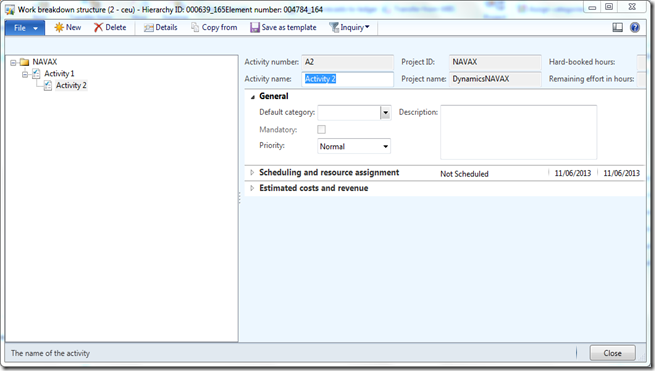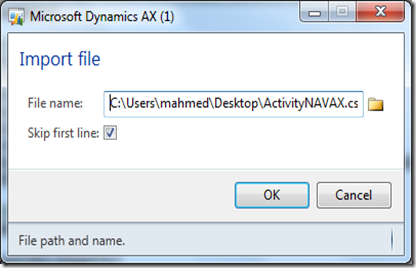I hope this is one of many import blog posts. No promises but I may look at the same written using the Data Import Export Framework to show a comparison.
To continue with the subject…
I wrote a job to import project work breakdown structure tree. The csv file is in this format.
Final outcome is like so.
The job code is below:
static void ImportActvities(Args _args)
{
AsciiIO asciiIO;
Filename filename;
NoYesId skipFirstLine;
Container line;
Dialog dialog;
DialogField dialogFileName, dialogSkipFirstLine;
int numProcessedRecords=0;
smmActivities smmActivities;
ProjTable projTable;
ProjActivity projActivity;
Hierarchy hierarchy;
HierarchyLinkTable hierarchyLinkTable;
HierarchyTreeTable rootHierarchyTreeTable, parentHierarchyTreeTable;
ProjId projId;
smmActivityNumber activityNumber, parentActivityNumber;
str name;
str parentElementNumber;
;
dialog = new Dialog("Import file");
dialogFileName = dialog.addField(extendedTypeStr(Filenameopen), "File name");
dialogSkipFirstLine = dialog.addField(extendedTypeStr(NoYesId), "Skip first line");
dialog.run();
if (dialog.run())
{
filename = dialogFileName.value();
skipFirstLine = dialogSkipFirstLine.value();
}
asciiIO = new AsciiIO(filename, 'R');
if (!asciiIO || asciiIO.status() != IO_Status::Ok)
{
throw error (strfmt("@SYS19312",filename));
}
asciiIO.inRecordDelimiter('\r\n');
asciiIO.inFieldDelimiter(',');
if (skipFirstLine)
line = asciiIO.read();
ttsBegin;
while (asciiIO.status() == IO_status::Ok)
{
line = asciiIO.read();
if (line)
{
projId = conpeek(line,1);
activityNumber = conpeek(line,2);
parentActivityNumber = conpeek(line,3);
name = conpeek(line,4);
}
projtable = Projtable::find(projId);
if (!projTable)
{
throw error(strFmt("Project %1 cannot be found", projId));
}
if (!activityNumber)
{
throw error(strFmt("Activity %1 cannot be found", activityNumber));
}
// if activityNumber is blank or activity can't be found then insert it
if (!smmActivities::find(activityNumber) && projTable)
{
//create root
hierarchyLinkTable = HierarchyLinkTable::findRefTableRecId(tableNum(ProjTable), projTable.RecId, true);
if (!hierarchyLinkTable)
{
//create Hierarchy record
hierarchy.clear();
hierarchy.initValue();
hierarchy.Name = projTable.Name;
hierarchy.Description = projTable.Name;
hierarchy.HierarchyType = HierarchyType::Project;
//use the number sequence or the project id as the hierarchyId. I prefer to use the Project id.
//hierarchy.HierarchyId = NumberSeq::newGetNum(CompanyInfo::numRefHierarchyId()).num();
hierarchy.HierarchyId = projTable.ProjId;
hierarchy.IsActive = NoYes::Yes;
hierarchy.insert();
//create HierarchyTreeTable root record
rootHierarchyTreeTable = HierarchyTreeTable::insertRoot(hierarchy.HierarchyId, projTable.ProjId);
HierarchyLinkTable::insertHierarchyLink(hierarchy.HierarchyId, tableNum(ProjTable), projTable.RecId);
}
else
{
if (hierarchyLinkTable)
{
hierarchy = Hierarchy::find(hierarchyLinkTable.HierarchyId, true);
select firstonly rootHierarchyTreeTable
where rootHierarchyTreeTable.HierarchyId == hierarchyLinkTable.HierarchyId &&
rootHierarchyTreeTable.ParentElementNumber == '';
}
}
parentElementNumber = '';
//parentActivityNumber is specified then find the node as the parent
if (parentActivityNumber)
{
parentHierarchyTreeTable = HierarchyTreeTable::findActivityNode(tableNum(ProjTable), projTable.RecId, parentActivityNumber);
if (parentHierarchyTreeTable)
{
parentElementNumber = parentHierarchyTreeTable.ElementNumber;
}
}
if (!parentElementNumber) //if parentElementNumber is blank, then use root node
{
parentElementNumber = rootHierarchyTreeTable.ElementNumber;
}
//create hierarchy tree node or activity
//if activityNumber is specified then create smmActivities. Otherwise, create a node without an activity
if (activityNumber)
{
// create smmActivities record
smmActivities.clear();
smmActivities.initValue();
smmActivities.ActivityNumber = activityNumber;
smmActivities.Purpose = name;
smmActivities.Category = smmActivityCategory::Task;
smmActivities.initFromProjTable(projTable);
smmActivities.insertParentLink(smmActivityParentType::Project, projTable.RecId, true);
smmActivities.insert();
// create ProjActivity record
if (!ProjActivity::exist(smmActivities.ActivityNumber))
{
projActivity.clear();
projActivity.initFromSmmActivities(smmActivities);
projActivity.insert();
}
HierarchyTreeTable::insertActivity(hierarchy.HierarchyId,parentElementNumber,smmActivities);
}
else
{
HierarchyTreeTable::insertNode(hierarchy.HierarchyId,parentElementNumber,name);
}
numProcessedRecords++;
info(strFmt("%1, %2 Record Processed", smmActivities.ActivityNumber,smmActivities.Purpose));
}
}
ttscommit;
info(strFmt("Imported: %1", numProcessedRecords));
}
Import dialog like so will appear.
- Get link
- Other Apps
Labels
AX2012R2 Data migration Xpp
Labels:
AX2012R2
Data migration
Xpp
- Get link
- Other Apps


